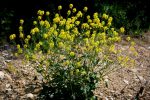 Also called bittercress, herb barbara, rocketcress, winter rocket, and wound rocket, this herbaceous biennial belongs to the mustard family, Brassicaceae, that also includes broccoli, alyssum, and stock. It is native to moist open sites in Europe and North Africa but has naturalized in North America where it grows in disturbed sites such as croplands, pastures, fallow fields, gardens, vacant lots, waste areas, and along roadsides. The genus name, Barbarea, is a reference to St. Barbara, the patron saint of artillerymen and miners because the plants were used to treat wounds caused by explosions. The specific epithet, vulgaris, is the Latin word meaning commonplace.
Also called bittercress, herb barbara, rocketcress, winter rocket, and wound rocket, this herbaceous biennial belongs to the mustard family, Brassicaceae, that also includes broccoli, alyssum, and stock. It is native to moist open sites in Europe and North Africa but has naturalized in North America where it grows in disturbed sites such as croplands, pastures, fallow fields, gardens, vacant lots, waste areas, and along roadsides. The genus name, Barbarea, is a reference to St. Barbara, the patron saint of artillerymen and miners because the plants were used to treat wounds caused by explosions. The specific epithet, vulgaris, is the Latin word meaning commonplace.
Description: Growing twelve to twenty-four inches tall, yellow rocket has a stout taproot that first produces a basal rosette of shiny, dark greens in winter, each with a large terminal lobe and smaller lower lobes. One or more ribbed hairless stems arise from the rosette in spring with smaller, ovate, lobed or toothed leaves, and dense terminal clusters of yellow flowers. Flowers each have four petals and are less than .5 inches across. The flowering continues into summer and is followed by the production of seedpods up to an inch long.
Control: Because of the long taproot, hand pulling is difficult, but mowing or cutting off the top portion of the plant before seed production will stop the plant from reseeding. Since it is a biennial, the plant will not return once the seed source is eliminated. In severe cases when plants have already gone to seed, a pre-emergent herbicide can be applied in late summer or early autumn to prevent germination or a post emergent herbicide can be used to kill new sprouts.
Photo Credit: Enrico Blasutto Wikimedia